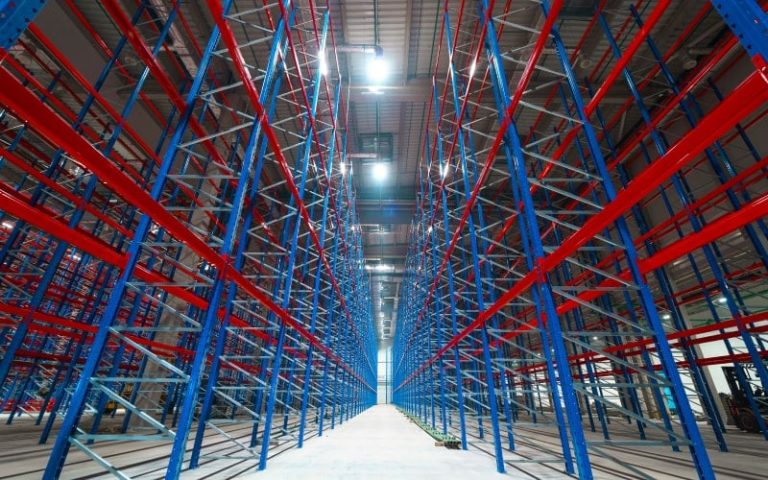More than half of all warehouse operators say finding reliable, quality labor is their top challenge in 2025. That’s not likely to change anytime soon. Wages are going up as well. In Q1 2025, warehouse wages grew 15%—nearly four times the national average for all occupations.
Despite economic uncertainty, more owners and managers are exploring the benefits of warehouse automation to overcome these challenges. As overhead costs continue to escalate, there’s a premium on efficiency and futureproofing warehouses to adapt quickly to the changing marketplace. While warehouse automation solutions are about much more than reducing labor costs, considering that the workforce makes up half or more of most warehouse budgets, it’s a key factor.
A recent survey of 65 top logistics and supply chain execs reported that 70% plan to increase their investment in warehouse automation solutions. Collectively, this group forecasts spending about $100 million on automated material handling equipment and warehouse automation systems, citing the need for reducing labor dependency and improving process stability and speed.
This guide walks you through everything you need to know about warehouse automation: current trends, leading technologies, return on investment (ROI) metrics, and a proven roadmap for implementation.
What Is an Automated Warehouse?
An automated warehouse leverages technology to manage tasks traditionally handled by human workers. This can include everything from transporting goods and storing inventory to automated warehouse picking, packing, and shipping.
The goal is to streamline operations by employing smart material handling equipment and warehouse automation systems, such as conveyor belts, automated storage and retrieval systems (AS/RS), mobile robots, smart sensors, and data-driven software platforms. These systems reduce manual intervention, boost productivity, and improve order accuracy, making them a smart investment for businesses of all sizes.
The State of Warehouse Automation in 2025
In 2023, Gartner made a bold statement: By 2027, 75% of companies will have adopted some form of “cyber-physical” technology, such as mobile robots, within their warehouse operations.
Yet, in 2025, only 20% of warehouses in North America have adopted any form of automation. For facilities looking to streamline and modernize throughput, there’s a long way to go. That number is expected to grow to 26% of warehouse sites that are automated, and spending reports are backing that up. Companies today are spending more than a third of their budgets on warehouse automation solutions.
The global warehouse automation market is growing at more than 10% a year, with companies spending $30 billion in 2024, a number that will nearly triple by 2033. Several factors are fueling this growth:
- E-commerce: Online shopping has amplified demand for high-speed, accurate order fulfillment.
- Labor market constraints: Skilled labor is hard to find and retain.
- Cost inflation: Rising wages and material costs make automation more cost-effective long term.
- Customer expectations: Same-day delivery and real-time tracking are the new norms.
- Tariffs and trade wars: Global trade tensions have increased the cost of goods and created unpredictable shipping dynamics, making efficiency and cost reduction even more urgent.
Key Warehouse Automation Technologies and Equipment
There are different types of warehouse automation that can work separately or in concert to streamline workflow. Here are the most common warehouse automation solutions
Material Handling Systems
Material handling is the backbone of warehouse automation systems. Key components include:
- Conveyor systems: Used to move goods through the facility efficiently. Common types include roller, belt, and spiral conveyors.
- Sortation systems: These automated systems scan items (via barcode or RFID) and route them to the correct destination.
- Truck loaders, pallet jacks, and lifts: Semi-automated solutions that assist with heavy lifting and movement and other equipment, such as automated forklifts.
Storage Systems
Automated storage maximizes space and improves retrieval times. Examples include:
- Automated Storage and Retrieval Systems (AS/RS): These systems use shuttles, cranes, and lifts to move goods in and out of storage with minimal human input.
- High-density racking: Racking systems that make the most of vertical space.
- Shelving systems: Shelving for organizing small parts.
Robotics and Automation Devices
Robotics plays a central role in the future of warehouse automation. These devices improve efficiency, accuracy, and scalability in several ways:
- Autonomous Mobile Robots (AMRs): Navigate warehouses without human guidance, transporting goods from one zone to another with precision.
- Collaborative Robots (Cobots): Work safely alongside humans, assisting with picking, packing, or transporting materials.
- Robotic picking arms: Equipped with computer vision and AI to identify, grasp, and sort products of varying shapes and sizes.
- Drones: Deployed in large facilities to conduct inventory audits, monitor high shelves, or deliver parts between sections.
Software and Analytics Tools
Today’s warehouses depend on intelligent software to tie everything together with automated warehouse management systems:
- Cloud-based warehouse management systems (WMS): Enable centralized control over inventory, orders, and workflows.
- Warehouse execution systems (WES): Coordinate real-time movement of goods and equipment.
- Data dashboards: Offer insights into KPIs like throughput, error rates, and system performance.
Artificial intelligence and machine learning are also helping to optimize operations, collecting and analyzing data from equipment and workflow, and applying dynamic adjustments to improve efficiency.
What Role Does AI Play in Warehouse Automation?
AI is transforming warehouse automation by adding speed, intelligence, and adaptability. McKinsey research shows that embedding AI in operations can reduce logistics costs by 5–20% while unlocking 7–15% more capacity and efficiency.
Here are some of the ways AI enhances operations.
AI-Powered Inventory Management
AI algorithms analyze historical trends and real-time inputs to predict demand. This ensures optimal stock levels, reduces waste, and prevents stockouts.
Smart Robotics and Automated Picking
Automated warehouse picking, powered by AI, uses computer vision and machine learning to direct robots to the correct item, pick it, and transport it accurately and efficiently.
Real-Time Decision-Making
AI analyzes data from across the warehouse to improve operational decisions, re-route congested pick paths, and identify inefficiencies. For example, monitoring traffic flow and cycle times can identify bottlenecks and make dynamic adjustments to improve output.
Compliance and Traceability
AI can document every product movement and ensure storage conditions comply with regulatory standards, reducing the risk of recalls or penalties.
Calculating the ROI from Warehouse Automation
Warehouse automation requires a significant investment, and you need to know the return you’re getting. The benefits of warehouse automation are obvious in the numbers:
- Reduces warehouse storage capacity needs by up to 50%
- Lessens operational errors by up to 99%
- Cuts labor costs by up to 60%
But ROI is not a one-size-fits-all calculation, however. It depends on the size of your warehouse, the level of automation you plan to integrate, and how you operate.
Here’s how to evaluate the full impact:
Direct Cost Reductions
Automating repetitive tasks like sorting, picking, and inventory checks reduces staffing needs and overtime expenses. Additionally, accuracy improves, resulting in fewer shipping errors and product returns.
Another cost benefit lies in space optimization. Automated systems can take advantage of vertical storage and reduce the need for wide aisles, maximizing the use of available square footage.
Long-Term Strategic Gains
Beyond short-term cost savings, the benefits of warehouse automation offer strategic advantages. Faster fulfillment speeds enhance customer satisfaction and competitiveness. More ergonomic work environments support employee retention, especially in physically demanding roles.
Energy-efficient systems and reduced equipment downtime also contribute to long-term savings. AI-powered predictive maintenance minimizes costly breakdowns and extends asset life.
Key Metrics to Track ROI
To measure the success of warehouse automation systems it’s essential to track the right performance metrics:
- Throughput per hour: Indicates how much product your system can handle over time.
- Cost per order: Tracks efficiency and profitability per transaction.
- Inventory turnover rate: Helps measure how efficiently goods are moving through your facility.
- System uptime: Reflects reliability and the impact of maintenance or breakdowns.
Tracking these KPIs provides insight into the effectiveness of your automation investment. You should measure and establish a baseline before automation begins so you can compare results post-implementation and calculate your true ROI with confidence.
Companies investing in warehouse automation systems and robotics are typically seeing ROI within two to three years, but it can take longer depending on the scope and scale of your investment.
Steps to Integrate Warehouse Automation Solutions
When it comes to planning, engineering, and integrating warehouse automation, mistakes can be really expensive. The wrong material handling equipment, automation systems, or layout can derail any savings you expect. McKinsey tells the story of a consumer goods company that invested more than $150 million to consolidate multiple existing warehouses into a single, fully automated facility…and failed. Today, much of the automation lies idle while the facility is mainly used for wholesale fulfillment.
You need expert guidance to make the right decisions for your organization. The material handling experts at Conesco Storage Systems can help design, engineer, equip, and install everything your warehouse needs.
Before beginning, however, you’ll need to plan and coordinate your strategy. Here are the key steps:
1. Evaluate Your Current Operations
Start by auditing your warehouse’s current processes. Identify issues such as fulfillment delays, inventory errors, space inefficiencies, and manual labor dependencies.
Collect data on current KPIs to use as a baseline and clarify what you’re trying to accomplish. The goals you set will be critical in determining the right material handling equipment and level of warehouse automation you need.
2. Define Your Automation Goals
Clarify what success looks like. Are you trying to:
- Reduce labor costs?
- Improve order accuracy?
- Increase storage capacity?
- Accelerate throughput?
3. Plan Your Layout and Workflow
Automation depends on smart design and careful planning. From pallet racks to pick modules, mezzanines, and conveyor systems to the latest warehouse automation solutions, everything must flow properly and work cohesively to optimize efficiency.
Reconfigure your layout to support efficient material flow, reduce travel time, and isolate automated zones for safety. Make sure to plan for scalability to accommodate any future growth or changes to materials or inventory mix.
4. Choose the Right Technologies
Select automation solutions that align with your goals. This may include:
- Conveyors to streamline item movement
- AS/RS to increase storage density
- AMRs for goods transport
- WMS and WES to orchestrate workflows
Depending on your scale and budget, an automation solution may include more advanced equipment like automated forklifts, advanced robotics, or automated guided vehicles.
Make sure new systems integrate well with your existing infrastructure and software.
5. Create a Realistic Implementation Plan
Unless you are equipping a new facility, you’ll likely need to stagger your automation rollout to avoid downtime. A realistic implementation timeline is critical, and you’ll need to build in some buffer to accommodate unexpected delays. For example, backlogs at the permitting office can disrupt your schedule.
Your plan should include:
- Milestones and deadlines
- Lead times and installation schedules
- Local permitting requirements (especially for racking or mezzanines)
- Engineer-stamped drawings and safety plans
6. Train and Prepare Your Staff
Automation changes how your team works. Offer upfront training on new systems, interfaces, and safety procedures to prepare them for new roles like system monitoring and troubleshooting.
7. Install, Test, and Fine-Tune
Work with experienced installers to get your material handling equipment in place and bring your systems online.
Run test cycles to catch inefficiencies before full-scale deployment so you can tweak layouts or software settings as needed. Even after you launch your warehouse automation solutions, you’ll want to monitor outputs and make adjustments along the way to optimize efficiency.
Prepare for the Future of Warehousing
Moving forward, warehouse automation will be essential to driving down your cost structure and maintaining margins. From conveyors and AS/RS to automated warehouse picking, AI, and real-time analytics, warehouse automation solutions are transforming how goods move, orders are fulfilled, and data is managed.
Whether you’re addressing labor shortages, trying to improve accuracy, or looking to scale, automation can help. The right system, customized for your layout, inventory, and budget, will deliver tangible ROI and long-term operational strength.
For expert guidance on warehouse automation planning, equipment selection, or system upgrades, request a consultation with the team of material handling experts at Conesco Storage Systems. As one of the nation’s largest suppliers of warehouse equipment, we can help you find exactly what you need.



